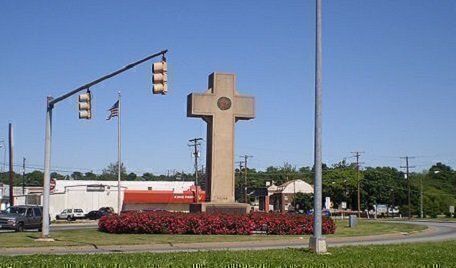Two different appeals at the Supreme Court are asking the Justices to reconsider rulings that bar the display of large crosses on public property, even if they have been in place for generations.
 Currently, the Court is expected to review in private conference this Friday a highly publicized pair of cases from Maryland about the Bladensburg Peace Cross. The American Legion and local families paid for the 40-foot-high monument in 1925 as a tribute to 49 veterans.
Currently, the Court is expected to review in private conference this Friday a highly publicized pair of cases from Maryland about the Bladensburg Peace Cross. The American Legion and local families paid for the 40-foot-high monument in 1925 as a tribute to 49 veterans.
And last month, a second case arrived from Pensacola, Florida, that is just beginning to go through the appeals process at the Supreme Court. That dispute centers on a 34-foot-high cross erected during World War II as a part of nondenominational services held in a park sponsored by a local Jaycees group.
The Maryland cases have been at the Court since late June, and nearly two dozen briefs have been filed. They most likely will be considered as a combined case.
The question asked in Maryland-National Capital Park and Planning Commission v. American Humanist Association and The American Legion v. American Humanist Association by the petitioners last June was this: “Whether the Establishment Clause requires the removal or destruction of a 93-year-old memorial to American servicemen who died in World War I solely because the memorial bears the shape of a cross.”
The memorial was erected on private property, but the planning commission later acquired the property due to traffic concerns. A split Fourth Circuit federal appeals court ordered the cross’s removal from the current property.
The petitioners argue the Fourth Circuit Court misapplied a constitutional test in its decision. The majority applied the Lemon test to determine if the monument was permitted on public property. In 1971, the Supreme Court ruled that a government action can violate the First Amendment’s Establishment Clause unless it has a significant secular purpose, doesn’t have the primary effect of advancing or inhibiting religion, and doesn’t foster an excessive entanglement between government and religion. The majority said the monument failed the second and third parts of the Lemon test because it closely resembled a cross.
Instead, the petitioners point to other Supreme Court decisions they believe contradict the Lemon test in this situation, including Van Orden v. Perry from 2005. In Van Orden, Justice Stephen Breyer said the presence of a Ten Commandments monument was permissible on public property because several factors showed that it served “a primarily nonreligious purpose.”
The American Humanist Association believes there isn’t a conflict between the Lemon test used by the Fourth Circuit and the Van Orden decision, and the cross is a religious symbol that dominates its location due to its size.
The second petition at the Supreme Court is City Of Pensacola, Florida v. Kondrat’yev and it has yet to go through the en banc process at the 11th Circuit Appeals Court. But the petitioners want the case expedited to the Supreme Court and combined with the two Maryland cases.
In the Pensacola case, the petitioners say the appeals court misapplied the Lemon test to rule that a cross that had been in a public park for 75 years couldn’t remain on the property.
The three-judge panel said it had to consider precedent from a 1983 11th Circuit decision in ACLU of Georgia v. Rabun County Chamber of Commerce, Inc. that forced it to use the Lemon test. Two of the judges in the Pensacola decision said the Supreme Court’s Establishment Clause jurisprudence since Lemon has been a “hot mess” and that 11th Circuit precedent conflicted with recent decisions.
In its appeal, the petitioners want the Supreme Court to also apply a more-recent decision, Town of Greece v. Galloway, which permitted prayers at local public government meetings, as allowing for the cross to remain in place.
Scott Bomboy is the editor in chief of the National Constitution Center.







